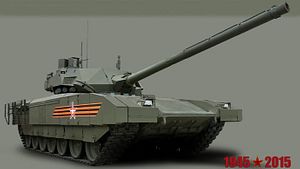The Russian Defense Ministry has concluded a contract with Uralvagonzavod (UVZ), the world’s largest tank maker, for the first batch of 100 third-generation T-14 main battle tank (MBT), an armored vehicle based on the “Armata” universal chassis system, according to local media reports.
“We have a contract for a pilot batch of more than 100 machines. They are already arriving for trials,” Russian Deputy Defense Minister Yuri Borisov told RIA news agency during the Army 2016 military and technology forum, which was held in the Moscow Region on September 6-11. (The Russian defense ministry also published a video of a T-14 tank showcasing its capabilities during the forum on September 10.)
Borisov also announced that the initial plan of inducting 2,300 T-14 MBTs by 2020 had to be pushed back to 2025, without offering additional details. However, budgetary constraints are the most likely answer. The T-14 was originally priced at about $8 million. According to some Russian defense officials, the price will come down to around 250 million rubles ($3.8 million) per unit once serial production begins.
While the CEO of Russian Technologies State Corporation (Rostec), Russia’s largest defense industrial conglomerate, claimed in a March 2016 interview that T-14 has already entered serial production, other sources indicate that this will not begin before 2018. As I reported previously (See: “Is Russia’s Deadliest Tank Already in Serial Production?”):
Whether the T-14 has entered serial production is hard to verify independently. It is possible that Chemezov was referring to a larger number of T-14 tanks produced in 2015 and currently undergoing operational trials. Vyacheslav Khalitov, the deputy director of Uralvagonzavod (UVZ) (…) said in an interview in February 2016 that his company has produced a trial batch of over 20 T-14 MBTs.
The T-14s showcased at the Army 2016 forum this month are likely from this trial batch. “We are also demonstrating our Armata, but now it poses not only as an exhibit but also shows its combat capabilities in dynamics and gunnery (during a closed viewing), which only happens for the first time at expositions,” Oleg Siyenko,the general director of UVZ, told TASS news agency on September 8.
Russia’s new MBT features an unnamed turret and will eventually be a completely automated combat vehicle that can be remotely controlled. According to Russian media reports, the T-14 will feature a number of technological innovations, including new ultraviolet (UV) detectors as part of the Armata’s active defense system to protect it from incoming enemy fire. The tank’s main weapon is the 2A82 125-millimeter smoothbore cannon, capable of firing high-powered munitions (10 shots a minute at an effective range of up to 7 kilometers), which will be replaced with a more powerful 152 mm cannon in later versions.
The T-14 is the first new MBT to be developed by Russia after the collapse of the Soviet Union. The T-14 Armata was first revealed in 2015 during the May 9 Moscow Victory Day Parade on Red Square. The Armata universal chassis system is a platform for over a dozen different tracked vehicles, including a self-propelled artillery gun, an armored military engineering vehicle, and an armored personal carrier. 70 percent of tracked armored vehicles of the Russian Ground Forces are slated to be replaced by vehicles based on the Armata universal chassis system.































